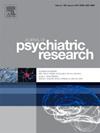探索PTSD伴失眠患者的情绪调节:一项基于任务的fMRI研究
IF 3.7
2区 医学
Q1 PSYCHIATRY
引用次数: 0
摘要
睡眠障碍和情绪调节困难是创伤后应激障碍(PTSD)的核心症状,两者密切相关。然而,这种关系背后的神经机制仍未得到充分探讨。为了解决这一空白,我们使用基于任务的功能磁共振成像(fMRI)来检查伴有和不伴有失眠的PTSD患者的情绪处理和调节相关的大脑机制。方法46例PTSD患者(伴失眠23例,无失眠23例)和对照组28例,分别报告临床症状(包括PTSD、失眠和焦虑/抑郁),并在fMRI期间完成转移注意情绪评价任务(SEAT)。基于全脑分析和ROI分析,我们比较了PTSD伴失眠和不伴失眠患者内隐情绪调节相关区域的神经差异。结果与无失眠症的PTSD患者相比,合并失眠症患者的左背外侧前额叶皮层(BA46)和左额下回(三角形部分,BA47)在内隐情绪加工过程中表现出明显的失活。此外,在基于评价的内隐情绪调节过程中,左侧颞下回(BA37)表现出明显的失活。此外,在ptsd -失眠组中,失眠严重程度与左梭状回的激活显著相关(BA37)。结论这些发现强调了PTSD伴失眠和不伴失眠患者之间差异的潜在神经机制。观察到的这些区域的改变可能作为PTSD合并失眠的神经生物标志物,并可能成为开发新的治疗干预措施的潜在目标。本文章由计算机程序翻译,如有差异,请以英文原文为准。
Exploring emotion regulation in PTSD with Insomnia: A task-based fMRI study
Background
Sleep disturbances and difficulties in emotion regulation are core symptoms of post-traumatic stress disorder (PTSD) and are closely related. However, the neural mechanisms underlying this relationship remain underexplored. To address this gap, we used task-based functional magnetic resonance imaging (fMRI) to examine brain mechanisms related to emotional processing and regulation in PTSD patients with and without insomnia.
Methods
Forty-six PTSD patients (23 with insomnia, 23 without insomnia) and 28 controls reported clinical symptoms (including PTSD, insomnia, and anxiety/depression) and completed the Shifted Attention Emotion Appraisal Task (SEAT) during fMRI. We compared the neural differences in implicit emotion regulation-related regions between PTSD patients with and without insomnia based on both whole-brain and ROI analyses.
Results
Compared to PTSD patients without insomnia, those with comorbid insomnia exhibited significant deactivation in the left dorsolateral prefrontal cortex (BA46) and the left inferior frontal gyrus (triangular part, BA47) during implicit emotion processing. Additionally, during appraisal-based implicit emotion regulation, the left inferior temporal gyrus (BA37) showed significant deactivation. Furthermore, in the PTSD-insomnia group, insomnia severity was significantly correlated with activation in the left fusiform gyrus (BA37).
Conclusions
These findings highlight potential neural mechanisms underlying the differences between PTSD patients with and without insomnia. The observed alterations in these regions may serve as neural biomarkers for PTSD with comorbid insomnia and could be potential targets for developing novel therapeutic interventions.
求助全文
通过发布文献求助,成功后即可免费获取论文全文。
去求助
来源期刊

Journal of psychiatric research
医学-精神病学
CiteScore
7.30
自引率
2.10%
发文量
622
审稿时长
130 days
期刊介绍:
Founded in 1961 to report on the latest work in psychiatry and cognate disciplines, the Journal of Psychiatric Research is dedicated to innovative and timely studies of four important areas of research:
(1) clinical studies of all disciplines relating to psychiatric illness, as well as normal human behaviour, including biochemical, physiological, genetic, environmental, social, psychological and epidemiological factors;
(2) basic studies pertaining to psychiatry in such fields as neuropsychopharmacology, neuroendocrinology, electrophysiology, genetics, experimental psychology and epidemiology;
(3) the growing application of clinical laboratory techniques in psychiatry, including imagery and spectroscopy of the brain, molecular biology and computer sciences;
 求助内容:
求助内容: 应助结果提醒方式:
应助结果提醒方式:


